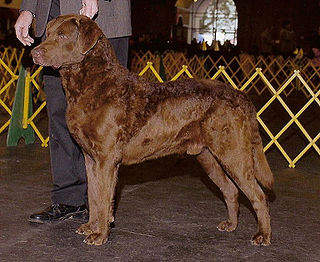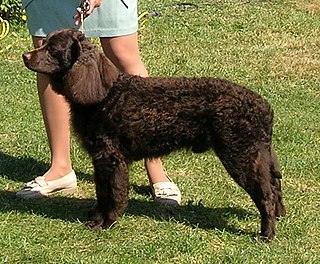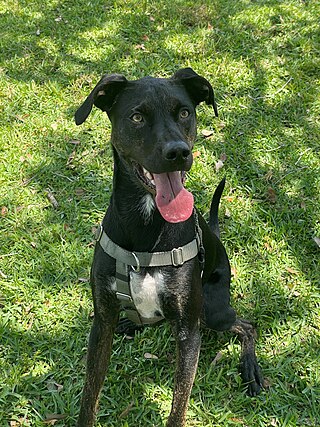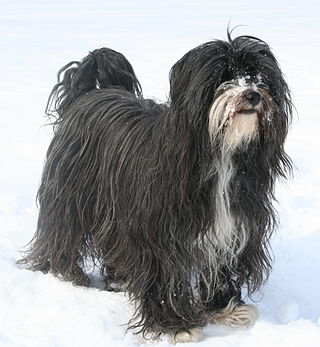
The beagle is a breed of small scent hound, similar in appearance to the much larger foxhound. The beagle was developed primarily for hunting hare, known as beagling. Possessing a great sense of smell and superior tracking instincts, the beagle is the primary breed used as a detection dog for prohibited agricultural imports and foodstuffs in quarantine around the world. The beagle is a popular pet due to its size, good temper, and a lack of inherited health problems.

The Ibizan Hound is a lean, agile dog of the hound family. There are two hair types of the breed: smooth and wire. The more commonly seen type is the smooth. Some consider there to be a third type, long, but the longhair is most likely a variation of the wire.

The Gordon Setter is a Scottish large breed of dog, a member of the setter family that also includes both the better-known Irish Setter and the English Setter. Setter breeds are classified as members of either the Sporting or Gundog Group depending on the national kennel club or council.

The Kooikerhondje is a small spaniel-type breed of dog of Dutch ancestry that was originally used as a working dog, particularly in an eendenkooi to lure ducks. Kooikers were popular in the 17th and 18th century and appear in paintings by Jan Steen.

The Labrador Retriever or simply Labrador is a British breed of retriever gun dog. It was developed in the United Kingdom from St. John's water dogs imported from the colony of Newfoundland, and was named after the Labrador region of that colony. It is among the most commonly kept dogs in several countries, particularly in the European world.

The Rhodesian Ridgeback is a large dog breed originally bred in Southern Africa. The original breed standard was drafted by F.R. Barnes, in Bulawayo, Southern Rhodesia, in 1922, and approved by the South African Kennel Union in 1927. Its forebears can be traced to the semi-domesticated ridged hunting and guardian dogs of the Khoikhoi. These were interbred with European dogs by the early colonists of the Cape Colony for assisting in the hunting of lions.

The Chesapeake Bay Retriever is a large breed of dog belonging to the retriever, gundog, and sporting breed groups. The breed was developed in the United States Chesapeake Bay area during the 19th century. Historically used by local market hunters to retrieve waterfowl, pull fishing nets, and rescue fishermen, it is today primarily a family pet and hunting companion, known for a bright and happy disposition; courage; willingness to work; alertness; intelligence; love of water; and hunting capabilities. The Chesapeake is a medium- to large-sized dog similar in appearance to the Labrador Retriever, but with a wavy coat.

The American Water Spaniel is a breed of spaniel which originated in the United States. It was developed in the state of Wisconsin during the 19th century from a number of other breeds, including the Irish and English Water Spaniels. The breed was saved by Dr. Fred J. Pfeifer, who set up the breed club and standard, and whose work led to recognition for the breed by the United Kennel Club, and later, the American Kennel Club. While they are the state dog of Wisconsin, they remain a rare breed.

The Goldendoodle is a designer dog created by crossbreeding a Golden Retriever and a Poodle. First widely bred in the 1990s, they are bred in three different sizes—each corresponding to the size of Poodle used as a parent.

A mongrel, mutt, or mixed-breed dog is a dog that does not belong to one officially recognized breed, including those that result from intentional breeding. Although the term mixed-breed dog is sometimes preferred, many mongrels have no known purebred ancestors.

Gun dogs or bird dogs are types of hunting dogs developed to assist hunters in finding and retrieving game, typically various fowls that are shot down on the flight. The term hunting dog is broad and includes all breeds and skills of hunting canines, but "gun dogs" refers to canines that are trained to work alongside a loud firearm while hunting or retrieving game. Gun dogs are divided into three main categories: pointers and retrievers, setters and spaniels, and water dogs.

The Small Münsterländer is a versatile hunting-pointing-retrieving dog breed that reached its current form in the area around Münster, Germany. The Large Münsterländer is from the same area, but was developed from different breeding stock and is not related as the names would suggest. Small Münsterländers bear a resemblance to both spaniels and setters but are more versatile while hunting on land and water. The Small Münsterländer is recognized by the Fédération Cynologique Internationale under Group 7, Section 1.2, Continental Pointing Dogs of Spaniel type, by the American Kennel Club as a Foundation Stock Service breed, and by The Kennel Club and the United Kennel Club as a gun dog. It is related to the Epagneul Français and the Drentsche Patrijshond.

The Stabyhoun, or Stabijhoun or Stabij, is one of the rarest dog breeds in the world. It hails from the Dutch province of Friesland; its origins lie in the forested region of eastern and southeastern Friesland. The breed has been mentioned in Dutch literature dating back to the early 1800s, but it was not until the 1960s that the breed became known outside its native province; the first Stabyhouns left the Netherlands some decades later, in the 2000s. The name Stabijhoun translates roughly to "stand by [me] dog". The dog is considered a Dutch national treasure. Today, there are only a few thousand Stabyhouns worldwide.

The Tibetan Terrier is a medium-sized breed of dog that originated in Tibet. Despite its name, it is not a member of the terrier group. The breed was given its English name by European travelers due to its resemblance to known terrier breeds. The Tibetan name for the breed, Tsang Apso, roughly translates to "shaggy or bearded ("apso") dog, from the province of Tsang". Some old travelers' accounts refer to the dog as Dokhi Apso or "outdoor" Apso, indicating a shaggy or bearded working dog which lives outdoors.

The Petit Basset Griffon Vendéen, or PBGV, is a breed of dog of the scent hound type, bred to trail hares in bramble-filled terrain of the Vendée district of France. The breed is known in the United States as "Petit" or "PBGV," in England as "Roughie," and in Denmark as "Griffon" or "Petit". The PBGV is one of six types of "basset"-type breeds recognised by the Fédération Cynologique Internationale (FCI).

The Finnish Lapphund is a hardy, easy going, medium-size breed of Spitz type. Traditionally it has been used for herding reindeer. Although it is one of the most popular dog breeds in its native country, Finland, it is not very numerous outside of the Nordic countries.

The Boykin Spaniel is a medium-sized breed of dog, a Spaniel bred for hunting wild turkeys and ducks in the Wateree River Swamp of South Carolina, in the United States. It is the state dog of South Carolina, where it was discovered and further developed by hunters in the early through mid 1900s. September 1 is Boykin Spaniel Day in South Carolina, originally established in 1984.
Progressive retinal atrophy (PRA) is a group of genetic diseases seen in certain breeds of dogs and, more rarely, cats. Similar to retinitis pigmentosa in humans, it is characterized by the bilateral degeneration of the retina, causing progressive vision loss culminating in blindness. The condition in nearly all breeds is inherited as an autosomal recessive trait, with the exception of the Siberian Husky (inherited as an X chromosome linked trait) and the Bullmastiff (inherited as an autosomal dominant trait). There is no treatment.
Collie eye anomaly (CEA) is a congenital, inherited, bilateral eye disease of dogs, which affects the retina, choroid, and sclera. It can be a mild disease or cause blindness. CEA is caused by a simple autosomal recessive gene defect. There is no treatment.

The Golden Retriever is a Scottish breed of retriever dog of medium size. It is characterised by a gentle and affectionate nature and a striking golden coat. It is commonly kept as a pet and is among the most frequently registered breeds in several Western countries. It is a frequent competitor in dog shows and obedience trials; it is also used as a gun dog and may be trained for use as a guide dog.























